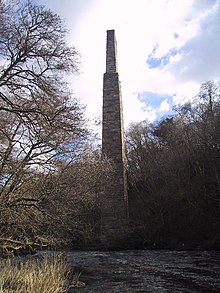
The Lesmahagow Railway, south of Glasgow in Scotland, was developed by a company known as The Lesmahagow Branches (later known as The Lesmahagow Guarantee Company). It was not an independent company in the usual sense. It was a financially independent, self-contained unit within the framework of the Caledonian Railway. The shareholders and officers of both companies were mainly the same people. The line was built largely to transport the vast amount of coal being produced by the many mines in the area. Royal assent was given to build the line in 1847 but construction did not commence till 1854. In 1856 the line was opened in stages. Later there was found to be a demand for passenger services which commenced in 1868. In 1923, with the grouping, the CR amalgamated with several other companies to form the London, Midland and Scottish Railway (LMS) which, following nationalisation in 1947, became part of British Railways.
Branches



Coalburn Branch
Main article: Coalburn BranchFrom Lesmahagow railway station to Bankend railway station.
Stonehouse Branch
Separates from the Coalburn branch at Dalserf Junction.
Blackwood Branch
Separates from the Coalburn branch at Southfield Junction.
Swinhill Branch
Built for Swinhill Colliery, the branch reaches Stonehouse Junction.
Construction

There were major difficulties building the line as, following rain, the ground took up the appearance and consistency of black mud. The line was built over a vast coalfield. In between the coal were large deposits of various other valuable minerals. There were several landslips as the embankments were being built. Two large viaducts had to be constructed - one at Nethan and another near Hamilton. The former had to be re-constructed a few years following the opening as the heavy coal trains were causing considerable damage. It had been built on a very low budget, and it was too low. Consequently, the approaches on both sides were very steep. In a costly rebuild iron piers were inserted between the existing stone ones and the rail level was raised by 19½ feet permitting an easing of the approach gradients. Even then the Nethan viaduct was a fragile structure and one of the highest in Scotland. A 20 m.p.h. speed limit was imposed on it. It was demolished in 1955. Lesmahgow station was high above and well east of the town. In July 1905 a roughly parallel line was built with a station closer to the centre of the town and the earlier station was renamed Brocketsbrae. Trains ceased to call at the latter station in 1951.
Running
From the start the line was extremely busy with mineral traffic. At one stage, eight engines were required to work the line and, owing to the weight of the coal being transported, they had to be the most powerful available. A large quantity of cannel coal was transported. This was a highly volatile mineral that was in demand by the gas industry. Apart from coal, several other minerals were found in the area, and transportation by rail was the preferred option. These included ironstone, limestone and sandstone. When passenger trains were introduced they were widely used by people travelling to and from work.
References
- ^ Thomas, John (1976). Forgotten Railways Scotland. David & Charles. pp. 81–84. ISBN 0 7153 7185 1.
- ^ Thomas, John (1971). A regional history of the Railways of Great Britain Volume V1 Scotland: the Lowlands and the Borders. David & Charles. pp. 151–152. ISBN 0 7153 5408 6.
- "Historic photos of Coalburn Station and the railway". Coalburn Heritage. Retrieved 15 June 2021.
- "The Railway". StonehouseOnline.org.uk. Retrieved 15 June 2021.
- "Swinhill Colliery". Durham Mining Museum. Retrieved 15 June 2021.
- "An open air school room for a geography lesson?". Geograph. Retrieved 22 October 2014.
| Lesmahagow | |
|---|---|
55°38′37″N 3°53′08″W / 55.6436°N 3.8855°W / 55.6436; -3.8855
Categories:- Caledonian Railway
- Closed railway lines in Scotland
- Standard gauge railways in Scotland
- Railway lines opened in 1856
- Railway companies established in 1847
- Railway companies disestablished in 1923
- 1847 establishments in Scotland
- British companies established in 1847
- 1923 disestablishments in Scotland
- British companies disestablished in 1923